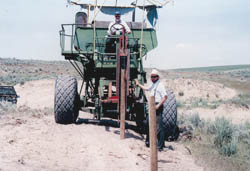
In eastern Washington State, worn out hillside combines are a dime-a-dozen (or less). When Herb Walter picked up a working one, he knew it would be ideal for the post driver he had in mind.
"We were always switching the post driver from one tractor to another or trying to find a free tractor to use with it. I was also tired of always having to look over my shoulder," he explains.
Walter pulled the combine home, gave it a tune up, and tore off everything but the engine, operator's platform and grain tank. All the hydraulics and electrical harness were left in place.
To mount the post driver where the header had been required building a framework. Walter had a quick-tach unit from an old Deere tractor that he planned to use with the driver. He used 3 by 3-in. angle irons to build the arms, connecting them to the old header pivot points. The header cylinders were connected to the new arms half way between the pivot points and the quick-tach unit.
To reinforce the arms, Walter installed cross bars and built a bridge over each arm with 2 1/4-in. steel strap. He welded the strap at either end of the arms. A piece of steel welded to the arm opposite the point where the cylinders connected to the arm spreads the strap away from the arm and puts it under tension, creating the bridge affect.
"The bridges keep the arms from buckling under the weight of the post driver," explains Walter. "Cross bars keep it from swaying or folding."
Walter used 2 1/2-in. steel pipe with a threaded rod in place of the top linkage for the 3-pt hitch. Turning the rod allows Walter to vary the angle of the quick-tach and thereby vary the angle of the post driver if needed.
He uses the hydraulic hoses originally used for the reel lift to raise and lower the driver head, while the header cylinder raises the driver itself for transport.
